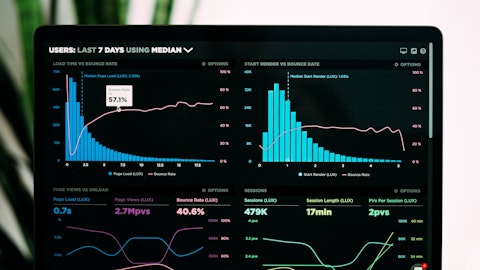Mike Smith: Yes, Steve, it’s Mike. I’ll take that. And if Brendan has any comments, he’ll layer then in. I mean we talk about pricing for the full year being around 1%, and that includes our price gap management, too. So don’t miss that point. And as you think about the first quarter, as I said before, that’s the majority of the lapping of last year’s pricing. First quarter, first half, that’s where a lot of the price activities come through, so less so in the second six. So I’d say that for the full year, we’re comfortable with pricing at one, I don’t know what math you’re looking at to make it negative, but I don’t see that, honestly, for the full year. And from a — and really by segment, too, you’ve got to think about it too. I mean Flavor Solutions is going to be a bit higher than 1%. Consumer is going to be a little bit lower from a pricing perspective. So we’re managing it very closely. And we’re comfortable with the full year guidance.
Steve Powers: Okay. Okay. Fair enough. I guess in Flavor Solutions, can you help just maybe a little bit more perspective on what you’re assuming both in terms of Flavor’s customer volume trends and restaurant traffic, both in the U.S. and overseas, where you’ve seen some softness to late? Just want to a little perspective there on that segment.
Brendan Foley: Sure, Steve. Our growth momentum in Flavor Solutions was pretty exceptional, I think, throughout the year in 2023 with double-digit growth in the first three quarters and slight volume growth there. But even with the deceleration in the fourth quarter, we had pretty strong organic growth throughout 2023. And we do expect to continue to make really good progress there. Although, we’re not going to be in double digits, I think, in 2024, but still making really good progress. To give you maybe more of a regional consideration, as I think through the portfolio. In the Americas, we continue to drive strong branded foodservice volume. And in flavors, particularly in a number of the categories that we tend to have some strong performance and like performance nutrition and beverage, we see continued strong performance in volume.
And I think that we would expect that to continue into 2024. Across the rest of the flavor product category, a lot of our growth was impacted by the softness of our customers’ performance in the market with regard to units and volume. And we saw a little bit more drop than we would have expected, not inconsistent with our own consumer business. And so while we’re disappointed in that softness, we still believe our results are pretty good in this area. I think that’s the chance of that continuing to 2024, probably likely. In EMEA, as we mentioned in our third quarter call, that our customers there are, both for packaged goods and also quick serve restaurants, are experiencing softness in their volumes within their business, too. And we anticipated that in the fourth quarter.
However, there’s even maybe a little bit more than what we expected. So almost like a similar theme to what I said about the U.S. And so we expect some softness related there as we enter in Q1. But we’re optimistic, again, that we’ll continue to sort of improve every quarter as we go through 2024. And then in Asia Pacific, our growth that was impacted by slower than expected restaurant traffic. Some of that really had to do with just unrelated matters, but some boycotts issues that we’re seeing in Southeast Asia. But we saw some nice performance in China, so I would expect that to continue in 2024 and some trends. So that’s just some context around Flavor Solutions.
Steve Powers: Okay. Thank you very much. I appreciate it. I’ll pass it on. Thank you.
Brendan Foley: Okay.
Operator: Thank you. Our next question comes from the line of Adam Samuelson with Goldman Sachs. Please proceed with your question.
Adam Samuelson: Yes. Thank you. Good morning everyone.
Brendan Foley: Good morning.
Adam Samuelson: Good morning. I wanted to come back to the consumer segment and maybe at a higher level. As we think about where the business and the specific categories are today versus where they were pre-COVID. Obviously, there’s enough number of consumption and occasion changes in terms — and distribution changes with inflation through the pandemic. But where are we today in your business and your key categories, as you think about price elasticity, as you think about price gaps and where there actually has been a lasting consumption change versus consumer behavior pre-pandemic.
Brendan Foley: Well, with so much has changed since 2019, I think that — if I think about the entirety of all the different levers and variables that you were talking about, whether it’s price elasticity or volume and where the consumer is, there’s been reasonably enough significant change that. As we take a look at our categories, we’re taking a look at in terms of how they’re performing today and where we need to go in order to drive volume growth. And as we said earlier, that’s a component of increased A&P. A lot of that advertising focused on talking about value. Parts of our portfolio, we know that price gap management can have a really effective impact on turning around unit volume trends. And so I think that’s an indication of where the consumer is right now.
If you look at unit volume performance, either in our business or probably the category, pricing has had an impact, and we have to acknowledge that. Having said that, though, if I compare our business organically, and product mix, compared to 2019, our total organic volume is about the same as 2019. We haven’t really lost significant volume or on product mix since pre-pandemic. And so I think that’s one sort of consideration to have is, while there’s been a lot of change in many ups and downs, I think, if you think about all these macro dynamic impacts we’ve been going through, we find ourselves in a similar volume position as we were in 2019. I don’t — I think I might have provided the context that you’re looking for.
Adam Samuelson: Okay. No, that’s helpful. And then, as we think about Flavor Solutions moving forward, just how do you think about — you see the competitive position of the portfolio today, what you’re seeing from your customers, the categories you’re in and the competitive set, do you feel like you have the breadth of portfolio? Do you think that the categories that are growing with your customers or you’re properly positioned to participate there? Or do you think that, as you look at kind of the — your peers, that there’s room to narrow the growth gap?
Brendan Foley: Well, as I think about our competitive posture in Flavor Solutions, I feel really good about it. It starts with having great capabilities in technology and a great team. And I think we do have a differentiated approach towards driving growth, particularly in flavors and seasonings in that part of our business. From a technology standpoint, we continue to win and sort of there’s — a lot of categories that we operate in there that we’re targeting because they’re positive and high growth. And we also tend to get a good mix of large customers and moderately in small-sized customers who tend to be characterized by much even higher growth. As we think about that as a portfolio mix of customers, we’re seeing a lot of strength coming from that.





